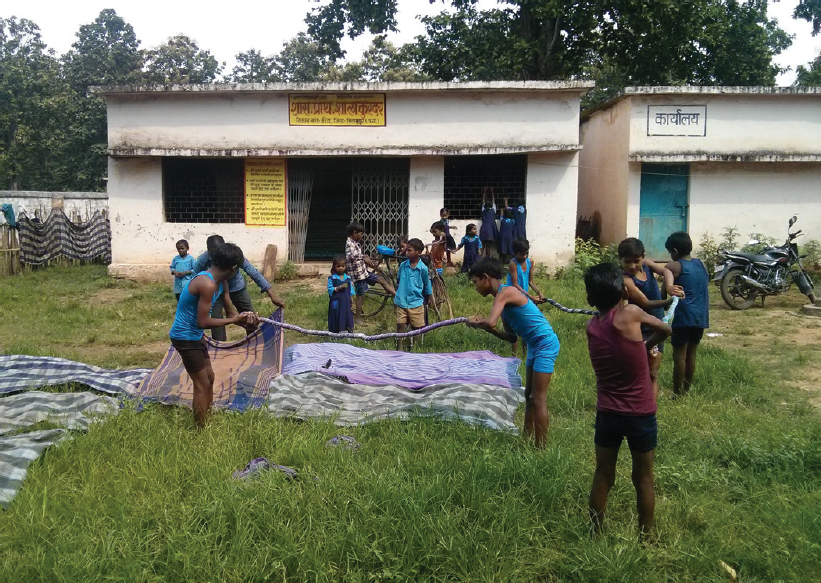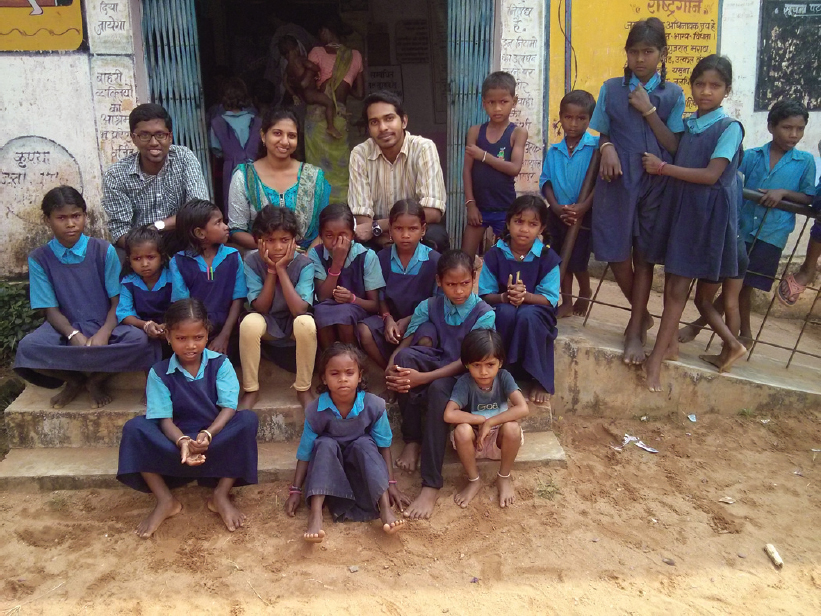Translate this page into:
Letter from Ganiyari
Corresponding Author:
Anissa Mary Thomas Thattil
Department of Community Health, St John's Medical College, Bengaluru, Karnataka
India
thomas.anissa@gmail.com
| How to cite this article: Thomas Thattil AM, Sunny S, Arasu S S, Joseph B. Letter from Ganiyari. Natl Med J India 2019;32:186-187 |
Unsung Heroes
We were first-year postgraduate students of community medicine when we visited Ganiyari, Chhattisgarh: the land of 36 forts.
We arrived at the crack of dawn and the first impression we had of Jan Swasthya Sahyog (JSS) was of the simple brick and lime mortar buildings—proud bearers of noble service. However, if we had arrived later in the morning, the buildings would have faded behind the multitude of patients milling about the place.
JSS or the Ganiyari Hospital, as the locals are more familiar with, was started in 1999 and is the brainchild of inspiring individuals who conceived a dream and went a step further by breathing life into it.
On a regular outpatient day, JSS sees a minimum of 120 patients. Many of these patients come from far and wait for days at a stretch. Almost all the patients come with their family for they decided that if healthcare could not come to them, they would just have to go where healthcare was. Understanding the hardships that their patients face, JSS ensures that the allotted 120 patients are examined, sent for the necessary investigations, reports collected, treatment started and sent home—all on the same day.
Although many of the doctors at JSS are super-specialists, they have ‘de-specialized’ themselves, i.e. all doctors see all patients, for they believe that the sick cannot be examined as just a respiratory case or a case of acute abdomen but need to be seen as a whole, as an individual. JSS is serious about the services it provides to the truly deserving and has pulled out all stops for the same. Early on, the founders of JSS realized that ‘people from small places do not just have small problems’.[1] In fact, they face bigger problems than their urban counterparts—problems compounded by poor socioeconomic status and the lack of health facilities. Ranging from complex neurosurgical procedures to telemedicine sessions, JSS is an exemplar in providing rural health services.
One among the many rural health issues, scabies is a serious public health problem, especially among children belonging to the lower socioeconomic strata and living in overcrowded areas.[2] A systematic review conducted by WHO on the Epidemiology and Management of Common Skin Diseases in children in developing countries found the prevalence of scabies to be 13%.[3] JSS thus decided to conduct a scabies prevention and treatment programme among tribal schools and hostels in their service area. Supported by the Ministry of Tribal Welfare, the team allotted for the scabies programme had adequate number of staff and was well stocked with supplies needed to make the programme a success. We were pleasantly surprised that our role was not restricted to examination and prescription of drugs. Instead, we too pitched in to drag mattresses and coverlets out into the sun, helped in washing the children’s clothes and bed linen in hot, sudsy water [Figure - 1] and [Figure - 2], bathed and applied lindane cream on the children after a thorough physical examination and distributed the necessary medications and lotions for those who had severe infestations and/or secondary infections. This programme would not have been possible but for the dedicated team of programme coordinators, health workers, social scientists and auxiliary nurse midwifery (ANM) interns—people whom we cannot forget and are forever thankful to.
 |
| Figure 1: Residents of the hostel washing and wringing out their bed sheets before putting them out to dry |
 |
| Figure 2: With residents of the hostel |
According to the National Family Health Survey-4, only 66.8% of deliveries in rural areas of Chhattisgarh take place in an institution.[4] Thus, instead of fighting tradition and asking women to deliver at hospitals far from their villages, dais or local birth attendants are trained. After an initial 6 months of intensive training for the traditional dais, revision classes are held at regular intervals at one of the sub-centres. We had the opportunity of attending one such class conducted at the JSS sub-centre in Shiv- Tarai. Attended by 28 trained dais (many of whom were not fortunate to have formal schooling), taught in the local language of Chhattisgarhi, with the help of PowerPoint presentations and videos, it was a beautiful blend of two very different worlds.
The National Family Health Survey-4 data show that in rural Chhattisgarh, 39.6% of under-five children are under-nourished, a figure lower than that in 2005-06.[4] To combat this problem, Phulwaris were created—crèches—for children between 6 months and 3 years. With the primary objective of fighting under-nutrition, children are provided with nutritious sattu powder—a mix of wheat, chickpea and sorghum with sugar, which is prepared by the villagers themselves, as well as two eggs a week. It is ensured that one Phulwari worker looks after only 10 children so as to provide optimum care and attention to each and every child. Run in 54 villages, with 83 phulwaris, they serve close to one thousand children. On the face of it, 1000 children might not seem to be much. However, look again. It not only means that 1000 children will grow up having nutritious food, with a good social and play environment. It also means that the mothers of these 1000 children can go to work and add to the family purse and that the siblings of these 1000 children need not skip school to look after their baby brother or sister.
Yet another challenge that JSS is dealing with is that of hypertension and diabetes. An all too prevalent disease in the urban, affluent regions, it takes on a different shape in rural areas. With a body mass index as low as 11 kg/m2 being common, these individuals face far more problems than their obese counterparts. By conducting regular non-communicable disease clinics and self-help groups, patients attending JSS are counselled and made aware of the importance of adherence to medications and self-care. Simultaneously, screening programmes are conducted and entire villages covered, one household at a time, with weight, height and blood pressure readings being placed on record for future reference. Considering that the villages are difficult to access, this is no mean feat.
JSS has extended its ever-expanding arms to encompass organic farming too. With over 400 varieties of rice, various vegetables and pulses being cultivated, it serves as an example of sustainable and successful organic farming as well as a seed bank of the locally cultivable plants. Further, understanding that appropriate health technology is one of the principles of primary healthcare, JSS took upon itself to invent an array of machines and materials that astounded us with their simplicity and scientific soundness. Delivery kits with locally available materials, steel drums with ultraviolet tube lights for disinfecting water, teaching stethoscopes with dual binaural, testing strips to detect water contamination, electrophoresis machines are but a few of them—all made with locally available materials and at minimal cost.
Most of us leave medical school with a spark in our eyes, a spring in our steps and a belief that we can make a change. However, thrown into the real world, disheartened by reality, the spark begins to fade and we start doubting ourselves. A few individuals by sheer determination and willpower made it possible for healthcare to reach forgotten parts of our land. Moreover, we, the postgraduate students hailing from different parts of the country, who had the fortune of visiting JSS, realized with a smile on our lips and the sputtering flame of hope growing strong in our hearts, that all is not lost, that we live in a land of unsung heroes.
Conflicts of interest. None declared
| 1. | Poverty Calculus. Heal Fellow Diary. Chhattisgarh:Jan Swasthya Sahyog. Available at www.jssbilaspur.org/poverty-calculus/ (accessed on 6 Apr 2019). [Google Scholar] |
| 2. | Hay RJ, Steer AC, Engelman D, Walton S. Scabies in the developing world: Its prevalence, complications, and management. Clin Microbiol Infect 2012; 18:313-23. [Google Scholar] |
| 3. | World Health Organization. Epidemiology and management of common skin diseases in children in developing countries. Geneva:Department of Child and Adolescent Health and Development, World Health Organization; 2005:4. Available at www.who.int/maternal_child_adolescent/documents/ (accessed on 26 Mar 2019). [Google Scholar] |
| 4. | Government of India. State Fact Sheet: Chhattisgarh, National Family Health Survey-4, 2015-16. India: Government of India; 2017:1-6. [Google Scholar] |
Fulltext Views
1,428
PDF downloads
787




